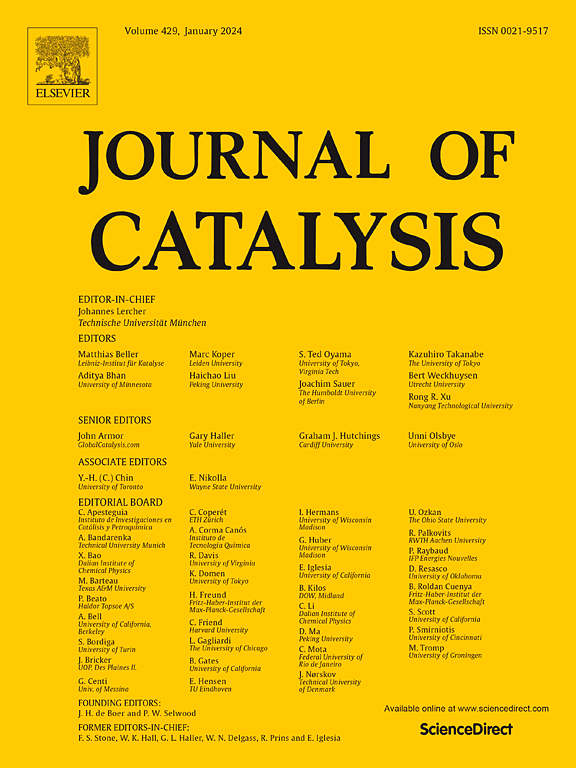An efficient catalyst from electrochemical self-reconstruction of NiFePBA/Ni(OH)2 for 5-hydroxymethylfurfural electrooxidation to produce high-valued 2,5-furandicarboxylic acid
IF 6.5
1区 化学
Q2 CHEMISTRY, PHYSICAL
引用次数: 0
Abstract
The utilization of sustainable lignocellulosic biomass for the production of high-value products could potentially solve the intensive reliance on fossil fuels. 2,5-furandicarboxylic acid (FDCA), obtained from 5-hydroxymethylfurfural (HMF) oxidation, is a significant precursor for biomass converted high-value chemicals. Nowadays, the rational design of pre-catalysts via electrochemical self-reconstruction provides an opportunity to design efficient catalysts for electrooxidation process. In this study, we developed a pre-catalyst consisting of nanoscale cubic NiFePBA anchored on Ni(OH)2. After electrochemical reconstruction, it demonstrated superior HMF oxidation reaction (HMFOR) performance. The results demonstrate that the electrochemical self-reconstruction process converts nanoscale cubic NiFePBA into nanosheeted metal oxyhydroxide, resulting in the formation of an oxygen defect-rich heterostructure with Ni(OH)2. This reconstruction process also enhance the electrochemically active surface area, thereby increasing the number of active sites. The combined effect of increased active sites and oxygen defects significantly enhances the HMF adsorption and the HMFOR activity. In situ electrochemical impedance spectroscopy further reveals that the reconstructed NiFePBA/Ni(OH)2-R exhibits accelerated reaction kinetics and reduced reaction potential during the electrocatalytic oxidation of HMF. The NiFePBA/Ni(OH)2-R catalyst exhibited exceptional electrochemical performance, achieving a high current density of 50 mA·cm–2 at a relatively low potential of 1.43 V vs. RHE. This performance is characterized by a remarkable 99.1 % conversion of HMF, 98.5 % selectivity for FDCA, and a Faradaic efficiency of 94.2 %. This study offers valuable insights for the development of high-performance HMFOR electrocatalysts.


电化学自重构 NiFePBA/Ni(OH)2,用于 5-羟甲基糠醛电氧化生成高价 2,5-呋喃二甲酸的高效催化剂
利用可持续的木质纤维素生物质生产高价值产品可能会解决对化石燃料的严重依赖。由5-羟甲基糠醛(HMF)氧化得到的2,5-呋喃二羧酸(FDCA)是生物质转化高价值化学品的重要前体。目前,通过电化学自重构对预催化剂进行合理设计,为设计高效的电氧化催化剂提供了契机。在这项研究中,我们开发了一种由纳米级立方NiFePBA锚定在Ni(OH)2上的预催化剂。经电化学重构,显示出优异的HMF氧化反应性能。结果表明,电化学自重构过程将纳米级立方NiFePBA转化为纳米片状金属氢氧化物,并与Ni(OH)2形成富氧缺陷异质结构。这种重建过程也增强了电化学活性表面积,从而增加了活性位点的数量。活性位点的增加和氧缺陷的共同作用显著提高了HMF的吸附和HMFOR活性。原位电化学阻抗谱进一步表明,重构的NiFePBA/Ni(OH)2-R在电催化氧化HMF过程中表现出加速的反应动力学和降低的反应电位。NiFePBA/Ni(OH)2 -R催化剂表现出优异的电化学性能,在相对于RHE的1.43 V的较低电位下实现了50 mA·cm-2的高电流密度。其特点是HMF的转化率为99.1% %,FDCA的选择性为98.5% %,法拉第效率为94.2 %。该研究为高性能HMFOR电催化剂的开发提供了有价值的见解。
本文章由计算机程序翻译,如有差异,请以英文原文为准。
求助全文
约1分钟内获得全文
求助全文
来源期刊

Journal of Catalysis
工程技术-工程:化工
CiteScore
12.30
自引率
5.50%
发文量
447
审稿时长
31 days
期刊介绍:
The Journal of Catalysis publishes scholarly articles on both heterogeneous and homogeneous catalysis, covering a wide range of chemical transformations. These include various types of catalysis, such as those mediated by photons, plasmons, and electrons. The focus of the studies is to understand the relationship between catalytic function and the underlying chemical properties of surfaces and metal complexes.
The articles in the journal offer innovative concepts and explore the synthesis and kinetics of inorganic solids and homogeneous complexes. Furthermore, they discuss spectroscopic techniques for characterizing catalysts, investigate the interaction of probes and reacting species with catalysts, and employ theoretical methods.
The research presented in the journal should have direct relevance to the field of catalytic processes, addressing either fundamental aspects or applications of catalysis.
 求助内容:
求助内容: 应助结果提醒方式:
应助结果提醒方式:


